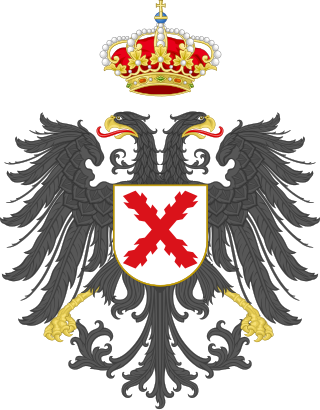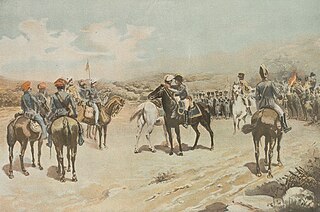
The American Revolutionary War, also known as the Revolutionary War or American War of Independence, was an armed conflict that was part of the broader American Revolution, in which American Patriot forces organized as the Continental Army and commanded by George Washington defeated the British Army. The conflict was fought in North America, the Caribbean, and the Atlantic Ocean. The war ended with the Treaty of Paris (1783), which resulted in Great Britain ultimately recognizing the independence of the United States of America.

The Carlist Wars were a series of civil wars that took place in Spain during the 19th century. The contenders fought over claims to the throne, although some political differences also existed. Several times during the period from 1833 to 1876 the Carlists—followers of Don Carlos (1788–1855), an infante, and of his descendants—rallied to the cry of "God, Country, and King" and fought for the cause of Spanish tradition against liberalism, and later the republicanism, of the Spanish governments of the day. The Carlist Wars had a strong regional component, given that the new order called into question region-specific law arrangements and customs kept for centuries.

Baldomero Fernández-Espartero y Álvarez de Toro was a Spanish marshal and statesman. He served as the Regent of the Realm, three times as Prime Minister and briefly as President of the Congress of Deputies. Throughout his life, he was endowed with a long list of titles such as Prince of Vergara, Duke of la Victoria, Count of Luchana, Viscount of Banderas and was also styled as "the Peacemaker".

The First Carlist War was a civil war in Spain from 1833 to 1840, the first of three Carlist Wars. It was fought between two factions over the succession to the throne and the nature of the Spanish monarchy: the conservative and devolutionist supporters of the late king's brother, Carlos de Borbón, became known as Carlists (carlistas), while the progressive and centralist supporters of the regent, Maria Christina, acting for Isabella II of Spain, were called Liberals (liberales), cristinos or isabelinos. Aside from being a war of succession about the question who the rightful successor to King Ferdinand VII of Spain was, the Carlists' goal was the return to a traditional monarchy, while the Liberals sought to defend the constitutional monarchy.

The Highland charge was a battlefield shock tactic used by the clans of the Scottish Highlands which incorporated the use of firearms.

Spain in the 19th century was a country in turmoil. Occupied by Napoleon from 1808 to 1814, a massively destructive "liberation war" ensued. Following the Spanish Constitution of 1812, Spain was divided between the 1812 constitution's liberal principles and the absolutism personified by the rule of Ferdinand VII, who repealed the 1812 Constitution for the first time in 1814, only to be forced to swear over the constitution again in 1820 after a liberal pronunciamiento, giving way to the brief Trienio Liberal (1820–1823).

The Third Carlist War, which occurred from 1872 to 1876, was the last Carlist War in Spain. It is sometimes referred to as the "Second Carlist War", as the earlier "Second" War (1847–1849) was smaller in scale and relatively trivial in political consequence.

Rafael Maroto Yserns was a Spanish general, known both for his involvement on the Spanish side in the wars of independence in South America and on the Carlist side in the First Carlist War.

The Convention of Vergara, entered into on 31 August 1839, was a treaty successfully ending the major fighting in Spain's First Carlist War. The treaty, also known by many other names including the Embrace of Vergara, was signed by Baldomero Espartero for the Isabelines and Rafael Maroto for the Carlists.

The British Auxiliary Legion, also called the British Legion or Westminster Legion, existed from 1835 to 1837. It was a British military force sent to Spain to support the Liberals and Queen Isabella II of Spain against the Carlists in the First Carlist War.

The Battle of Oriamendi was fought on 16 March 1837 during the First Carlist War. The battle was an overwhelming victory for the Carlists.

The Battle of Luchana occurred at Bilbao and its vicinities during the night of December 23, 1836 and went on until December 24, 1836. The Carlists were besieging Bilbao and controlled the water and land routes towards the city. The battle of Luchana took place in the district belonging to the parish of Deusto and the municipality of Erandio, on the banks of the Asúa River, which empties into the Nervión at the spot known as Luchana. The Carlists were defeated and the siege of Bilbao was lifted.

The Battle of Ramales, a battle of the First Carlist War, occurred at Ramales in Cantabria on May 12, 1839. The successful Liberals were commanded by Baldomero Espartero, the Carlists by Rafael Maroto.
The Battle of Alsasua, also known as the Battle of Altsasu or la Acción de la Venta de Alsasua, occurred on April 22, 1834 in Navarre, Spain, during the First Carlist War. Carlist general Tomás de Zumalacárregui attacked a convoy led by the Liberal general Vicente Genaro de Quesada traveling from Vitoria-Gasteiz to Pamplona at the town of Alsasua.
Events from the year 1837 in the Kingdom of Spain.

The siege of Lier of 1582, also known as the capture of Lier or betrayal of Lier, took place between 1 and 2 August 1582 at Lier, near Antwerp, during the Eighty Years' War and the Anglo-Spanish War (1585–1604). On 2 August the Spanish army commanded by Governor-General Don Alexander Farnese, Prince of Parma, supported by part of the States garrison, captured and seized the town, defeating the rest of the Dutch, English and German troops under Governor of Lier. The entire garrison was killed or captured. The news of the Spanish victory at Lier was a shock to the States-General at Antwerp, where the sense of insecurity was obvious, and many of the Protestant citizens sold their houses and fled to northern Flanders.

The reign of Isabella II has been seen as being essential to the modern history of Spain. Isabella's reign spanned the death of Ferdinand VII in 1833 until the Spanish Glorious Revolution of 1868, which forced the Queen into exile and established a liberal state in Spain.

The Battle of Andoain was a military engagement of the First Carlist War that was fought on 14 September 1837. It took place around the Basque village of Andoain, south of the main Liberal stronghold of San Sebastián. Liberal troops under Leopoldo O'Donnell had captured Andoain on 9 September, driving the Carlist garrison there to the western bank of the Oria. Over the next three days, both sides constructed breastworks amidst intermittent skirmishes. After two days of trench warfare, Carlist troops poured heavy artillery fire on the Liberal lines and launched an all-out offensive, supported by reinforcements brought in from Navarre by José Ignacio de Uranga.

The Royal Expedition, also known as Don Carlos' Expedition, was an 1837 operation in the late stages of the First Carlist War undertaken by the Carlist insurgents. Marking the highest point of Carlist control, it ended with a humiliating defeat and laid the groundwork for the end of the war in 1839.

Queen Isabella II of Spain was barely three years of age when her father, King Ferdinand VII, died on 29 September 1833. The years of her minority were marked first by the regency of her mother, Maria Christina of the Two Sicilies, and then under General Baldomero Espartero, covering almost the first ten years of her reign, until 23 July 1843, when Isabella was declared to be of age.

















